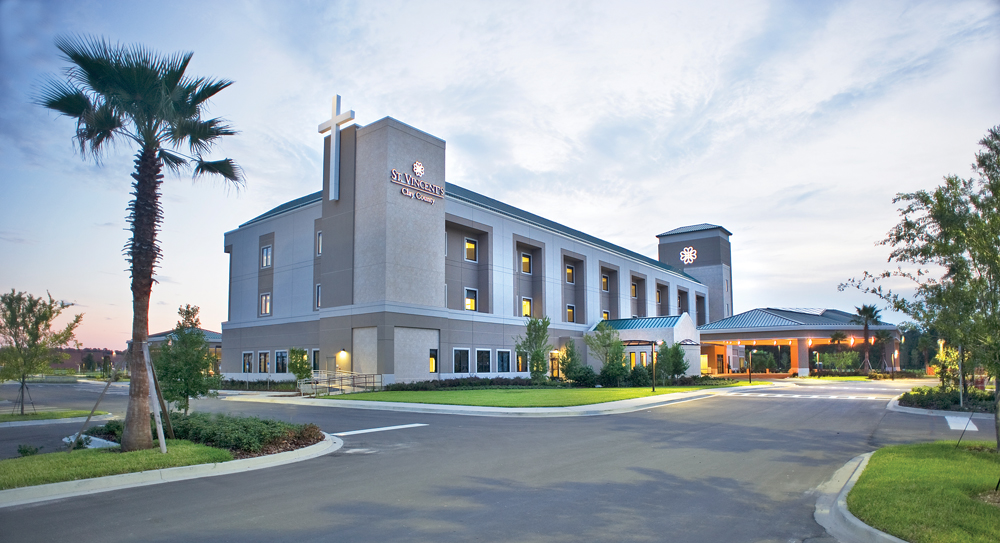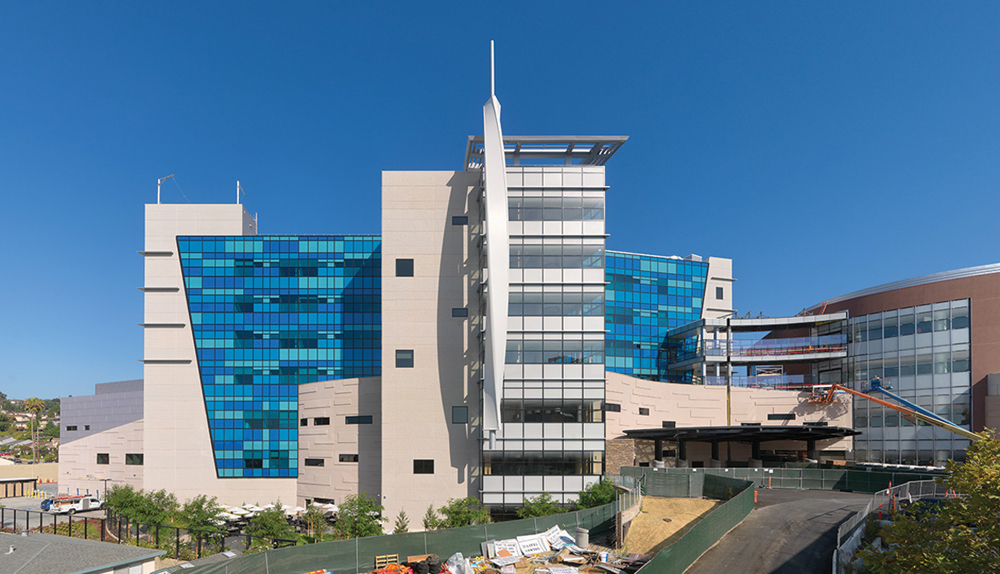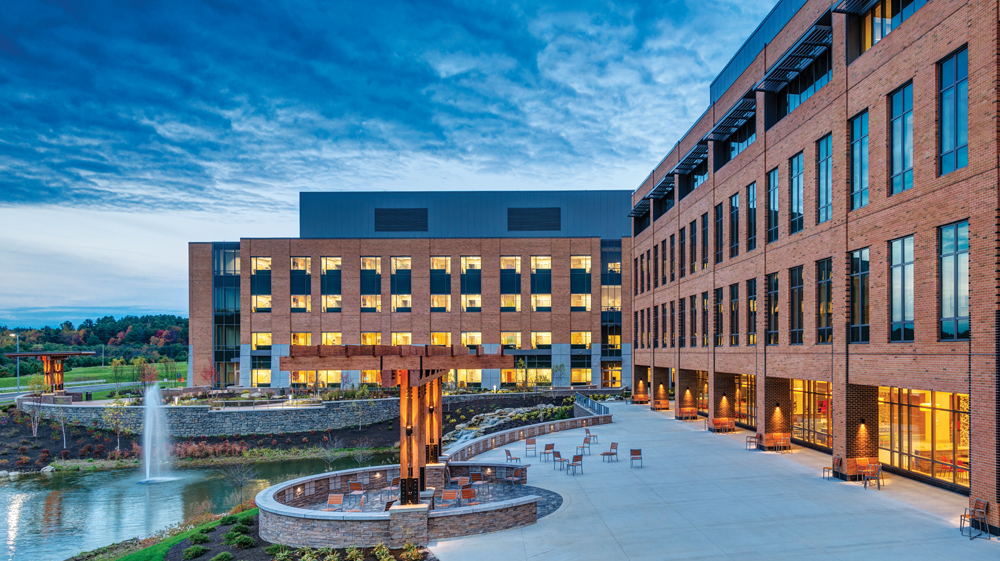Editor's note: This article was originally published as part of BD+C's two-part March 2014 Healthcare Facilities Report. Read the second installment of the report, "6 keys to better healthcare design."
Recent efforts to curb healthcare spending by the federal government and insurers appear to be working, something most Americans would say is a good thing—unless, of course, you’re the poor healthcare property management executive at a struggling healthcare provider.
Total U.S. spending on healthcare grew 3.7% in 2012, marking the fourth straight year of “low growth,” according to the Centers for Medicare & Medicaid Services (CMS). This compares with annual increases as high as 16% in past years, according to the CMS, which has been tracking healthcare costs since the 1960s.
According to the American Hospital Association:
• Medicare and Medicaid payments to hospitals have been cut by an estimated $113 billion since 2010.
• Underpayment by Medicare and Medicaid to U.S. hospitals reached $56 billion in 2012.
• U.S. hospitals provided $45.9 billion in uncompensated care in 2012.
Revenue projection is critical to capital expenditure planning, and uncertainty over how the Affordable Care Act will impact hospital reimbursements only adds to the complexity of the problem. If the law helps enough people get insurance, hospitals could get paid for care they now provide free to the uninsured. On the other hand, the ACA could send a flood of previously uninsured patients seeking expensive treatments that could strain capacity.
5 Tips For Winning More Healthcare Work
TIP 1 - "We want the people who are handling our work to have some clout within the firm. If something unexpected happens and we need an all-out effort, we want people who can go to leadership and get resources committed. We also like firms that are able to devote resources to healthcare design research."
— Bob McCoole, Senior Vice President, Facilities Resource Group, Ascension Health
TIP 2 - “During interviews, we only allow those directly involved in the project in the room. We don’t allow principals or marketing people—only PMs and superintendents. We don’t want marketing people trying to dazzle us. We also look for a good track record on safety and disruption avoidance.”
— John A. Balzer, MSEM, Vice President, Facility Planning and Development, Froedtert & the Medical College of Wisconsin
TIP 3 - “When making a proposal, we like to see firms that understand the market at the campus, our competition, and the history and layout of the campus.”
— Jim Young, Director, Capital Project Management, CHE Trinity Health
TIP 4 - “Part of engaging well in the IPD process is having an enculturation of collaboration. Some firms and individuals don’t seem to have that, but over time, the number of firms that we are excusing from projects for that reason is shrinking.”
— Carl Scheuerman, FACHE, Director of Regulatory Affairs, Sutter Health
TIP 5 - “Architects need to keep their egos in check, be open-minded, and understand that there are going to be a whole lot more people developing the drawings than themselves. We have a draw-once strategy. We didn’t want to recreate drawings. Architects and fabricators sat side by side. Electricians and mechanics worked together as team.”
— Paul Stein, Chief Operating Officer, MaineGeneral Medical Center
Furthermore, the underlying goal of the ACA is to reward hospitals for improving quality of care, rather than paying providers for services no matter what the outcome for patients. Then there are the penalties. Last year, hospitals with readmission rates considered excessive began having their reimbursement rates trimmed. Next year, hospitals with high rates of hospital-acquired infections will start seeing their reimbursement rates cut even more severely. All this makes accurate forecasting of hospital space needs no better than semi-educated guesswork.
In a year or two, the reimbursement picture should become clearer. For now, healthcare facility planners can count on two things: 1) they need to help rein in costs as much as possible, particularly through greater efficiency, and 2) they need to do everything they can to improve patient outcomes.
To get a boots-on-the-ground perspective, Building Design+Construction asked seven top healthcare industry capital planning executives for their views on how the upheaval in healthcare impacts capital planning, new construction, and renovations. Thought their institutions share some common coping strategies, each has different areas of emphasis. But there’s one thing all our experts agreed on: Capital is in short supply and is likely to get even tighter this year.
ASCENSION HEALTH: THE BUMPY ROAD TO OUTPATIENT SERVICES
Ascension Health is the nation’s largest Catholic and largest nonprofit healthcare system, with 1,500 locations in 23 states. For Ascension, the migration to same-day surgeries and procedures hovers like a specter over the organization’s facility planning.
“Everybody knows we as an industry need to move from the inpatient model to more of an outpatient model, but that doesn’t mean there is going to be a flood of capital available,” says Bob McCoole, who oversees Ascension’s facilities. Given the pressures to improve services on tighter budgets, McCoole sees a need for fundamental change in healthcare design. “If the facilities we design today look like what’s been built before, we’re not accomplishing anything,” he says.
“We are scouring opportunities to lower costs in every area of the business,” says McCoole. McCoole and Ascension executives are striving to identify the appropriate level of contribution to cost reduction by the physical plant. On average, facilities account for 8-12% of overall healthcare expenditures, he points out, and there are several areas ripe for cost cutting.
At the top of the agenda: a systemwide review of all properties in order to consolidate facilities. Ascension has hired a real estate consulting firm to pore through its entire portfolio—hospitals, ambulatory centers, and medical offices—for consolidation opportunities. The consultant will also be looking to “comb leases for accuracy of terms” and to assess maintenance costs.
Also on tap: energy-efficiency retrofits, further development of design standards, and a review of the organization’s preferred design firm list for projects of more than $10 million.
CHE TRINITY HEALTH: CONSOLIDATING TO COMPETE
Last May, Trinity Health merged with Catholic Health East, creating CHE Trinity Health, one of the nation’s largest Catholic healthcare systems. It has a presence in 20 states with 82 hospitals, 88 continuing care facilities, and home health and hospice programs.
The newly minted merger presents Jim Young, Capital Project Management Director, with the task of bringing the two cultures together. “Legacy Trinity,” as Young calls the pre-merger entity, “had a more centralized approach to capital project management and real estate.” Updating design standards for the merged organization is being looked at as a means to control costs, with a focus on stabilizing room size and expenditures on aesthetics.

Ascension Health’s 155,395-gsf, 64-bed St. Vincent’s HealthCare hospital, in Jacksonville, Fla. Building Team: HKS (architect), UHS Building Solutions (design-build firm), TLC Engineering for Architecture (MEP), Prosser Hallock (CE), TME Inc. (commissioning engineer), Miller Electric Co., W.W. Gay Mechanical Contractor, HBS Healthcare Building Solutions, and Brasfield & Gorrie (GC). The three-story tower has six ORs, 32 med/surg beds (orthopedics and neurology), a 24-bed general medical surgical floor, an eight-bed ICU, a 16-bay ED, a catheterization lab, and a check-in kiosk with palm scanner. Photo: Lans Stout
As much as cost cutting seems the right way to go, market forces also have to be plugged into the equation. “We’re in some very competitive markets where the state of competitors’ facilities is often at a high level,” says Young. “People interpret facility quality and appearance as an aspect of good healthcare.” So there is pressure to stay on par with what competitors are building where supported by a strong business case.
Another focus is energy savings upgrades, as well as an effort to boost efficiency on major renovations and new construction by using commissioning agents early in projects. Young says commissioning has already proven its worth on CHE Trinity projects.
SUTTER HEALTH: WINDING DOWN THE seismic SPENDING SPREE
Sutter Health serves more than 100 communities in Northern California with 21 hospitals and medical centers. The organization is in the latter stages of a huge construction program to comply with the California Hospital Seismic Safety Act, which was enacted in the wake of the deadly 1994 Northridge earthquake.
“The Act pushed us a little bit further into the future than maybe we wanted,” says Carl Scheuerman, FACHE, Sutter’s Director of Regulatory Affairs. The law, which mandated stiff requirements for seismic resilience in hospital retrofits or new construction, pushed California hospitals to the forefront of the inpatient-to-outpatient trend. According to Scheuerman, “At the onset, the big question was should we take half-measures to retrofit buildings, or make major investments in new buildings?” It was determined that, in most cases, retrofits would merely have extended the life of outdated facilities at a high cost, so new construction was usually the chosen path.
With the hospital building spree winding down, “The lion’s share of capital is going to be spent on the ambulatory environment,” says Sutter Health’s Planning and Design Chief, Dan Conwell. Many of these projects will be for small, highly focused services often located in strip malls. Sutter will also roll out more “express care clinics” in supermarkets or drugstores to provide low-cost services closer to the customer.
MAINEGENERAL: FINDING EFFICIENCIES EVERYWHERE
When MaineGeneral’s new Alfond Center for Health opened last November, it more than doubled the inpatient capacity of the organization’s two existing hospitals. One of those facilities, the Thayer Center for Health, is undergoing a major renovation and conversion to an emergency and outpatient facility. The $322 million being spent on these two projects represents a once-in-a-lifetime opportunity to remake this small healthcare system centered in the capital city of Augusta.

Sutter Health Eden Medical Center, Castro Valley, Calif. The 220,000-sf, 130-bed acute care facility was completed through an 11-party IPD agreement led by DPR Construction, with architect Devenney Group. The hospital has a 22-bed emergency department and a 34-bed universal care center. Rien Van Rijthoven
In Yankee tradition, the organization carefully measured how every dollar would be spent. “Where do we spend to get efficiencies and return on investment?” says COO Paul Stein. “We have one chance to do this, so we better get it right.”
Many stakeholders were involved in the planning for the Alfond Center—medical and non-medical staff, facilities/maintenance personnel, a Patient Family Advisory Council, and the hospital’s Lean process team, which is composed of four highly trained specialists who focus on analyzing hospital processes, recommending ways to improve efficiency, and training staff on how to implement those improvements. The Lean process team also contributes to the design of interior spaces, particularly in influencing layout standards and features that impact the flow of patients, physicians, and staff.
FROEDTERT & MEDICAL COLLEGE OF WISCONSIN: ‘RIGHT CARE, RIGHT PLACE, RIGHT TIME’
Froedtert & the Medical College of Wisconsin, centered in Milwaukee, is a regional healthcare network made up of three hospitals and more than 30 primary and specialty care health centers and clinics. The 500-bed Froedtert, the region’s only teaching hospital, is located on prime real estate in downtown Milwaukee.
Capital planning for the hospital is guiding by the principle that downtown space should house the highest-value services. For example, a current project to relocate some orthopedic services from the downtown campus will free up space for higher-end procedures such as organ transplants and cardiovascular care, says John A. Balzer, MSEM, Vice President of Facility Planning and Development. “Just as retailers track revenue per square foot, we do similar analyses of our facilities,” he says.
Another key principle at Froedtert: “Provide the right care at the right place at the right time.” This strategy prompts expansion to communities so that patients have convenient access to care. “Utilization goes hand in hand with efficiency,” says Balzer. That means before the organization builds or leases new space, it looks to add evening and weekend hours at existing facilities. This can keep down costs on real estate, as well as increase convenience for patients—another key organizational goal.
New technology is impacting capital planning at the academic medical campus. A project to bring 30 operating suites up to modern standards in order to accommodate the latest surgical equipment is under design. “Thirteen operating rooms are under 500 sf,” says Balzer. “The standard today is 650 sf and up.”
The editors wish to thank the following healthcare capital planning executives for serving as experts for this report:
Rick Albert, Director of Plant Operations, MaineGeneral Medical Center
John A. Balzer, MSEM, Vice President, Facility Planning and Development, Froedtert & the Medical College of Wisconsin
Dan Conwell, AIA, NCARB, Director, Planning, Architecture and Design, Sutter Health
Bob McCoole, Senior Vice President, Facilities Resource Group, Ascension Health
Carl Scheuerman, FACHE, Director, Regulatory Affairs, Sutter Health
Paul Stein, Chief Operating Officer, MaineGeneral Medical Center
Jim Young, Director, Capital Project Management, CHE Trinity Health
Related Stories
| Aug 11, 2010
Luxury Hotel required faceted design
Goettsch Partners, Chicago, designed a new five-star, 214-room hotel for the King Abdullah Financial District (KAFD) in Riyadh, Saudi Arabia. The design-build project, with Saudi Oger Ltd. as contractor and Rayadah Investment Co. as developer, has a three-story podium supporting a 17-story glass tower with a nine-story opening that allows light to penetrate the mass of the building.
| Aug 11, 2010
Three Schools checking into L.A.'s Ambassador Hotel site
Pasadena-based Gonzalez Goodale Architects is designing three new schools for Los Angeles Unified School District's Central Wilshire District. The $400 million campus, located on the site of the former Ambassador Hotel, will house a K-5 elementary school, a middle school, a high school, a shared recreation facility (including soccer field, 25-meter swimming pool, two gymnasiums), and a new publ...
| Aug 11, 2010
New Jersey's high-tech landscaping facility
Designed to enhance the use of science and technology in Bergen County Special Services' landscaping programs, the new single-story facility at the technical school's Paramus campus will have 7,950 sf of classroom space, a 1,000-sf greenhouse (able to replicate different environments, such as rainforest, desert, forest, and tundra), and 5,000 sf of outside landscaping and gardening space.
| Aug 11, 2010
U.S. firm designing massive Taiwan project
MulvannyG2 Architecture is designing one of Taipei, Taiwan's largest urban redevelopment projects. The Bellevue, Wash., firm is working with developer The Global Team Group to create Aquapearl, a mixed-use complex that's part of the Taipei government's "Good Looking Taipei 2010" initiative to spur redevelopment of the city's Songjian District.
| Aug 11, 2010
Florida mixed-use complex includes retail, residential
The $325 million Atlantic Plaza II lifestyle center will be built on 8.5 acres in Delray Beach, Fla. Designed by Vander Ploeg & Associates, Boca Raton, the complex will include six buildings ranging from three to five stories and have 182,000 sf of restaurant and retail space. An additional 106,000 sf of Class A office space and a residential component including 197 apartments, townhouses, ...
| Aug 11, 2010
Restoration gives new life to New Formalism icon
The $30 million upgrade, restoration, and expansion of the Mark Taper Forum in Los Angeles was completed by the team of Rios Clementi Hale Studios (architect), Harley Ellis Devereaux (executive architect/MEP), KPFF (structural engineer), and Taisei Construction (GC). Work on the Welton Becket-designed 1967 complex included an overhaul of the auditorium, lighting, and acoustics.
| Aug 11, 2010
Best AEC Firms to Work For
2006 FreemanWhite Hnedak Bobo Group McCarthy Building Companies, Inc. Shawmut Design and Construction Walter P Moore 2007 Anshen+Allen Arup Bovis Lend Lease Cannon Design Jones Lang LaSalle Perkins+Will SmithGroup SSOE, Inc. Timothy Haahs & Associates, Inc. 2008 Gilbane Building Co. HDR KJWW Engineering Consultants Lord, Aeck & Sargent Mark G.
| Aug 11, 2010
High-Performance Workplaces
Building Teams around the world are finding that the workplace is changing radically, leading owners and tenants to reinvent corporate office buildings to compete more effectively on a global scale. The good news is that this means more renovation and reconstruction work at a time when new construction has stalled to a dribble.
| Aug 11, 2010
Great Solutions: Business Management
22. Commercial Properties Repositioned for University USE Tocci Building Companies is finding success in repositioning commercial properties for university use, and it expects the trend to continue. The firm's Capital Cove project in Providence, R.I., for instance, was originally designed by Elkus Manfredi (with design continued by HDS Architects) to be a mixed-use complex with private, market-...
| Aug 11, 2010
Nurturing the Community
The best seat in the house at the new Seahawks Stadium in Seattle isn't on the 50-yard line. It's in the southeast corner, at the very top of the upper bowl. "From there you have a corner-to-corner view of the field and an inspiring grasp of the surrounding city," says Kelly Kerns, project leader with architect/engineer Ellerbe Becket, Kansas City, Mo.








